EDWIN CAICEDO and ERNESTO CORTÉS
Environment Desk
Editor's note: This text is an artificially intelligent English translation of the original Spanish version, which can be found here. Any comment, please write to [email protected]
En este portal utilizamos datos de navegación / cookies propias y de terceros para gestionar el portal, elaborar información estadística, optimizar la funcionalidad del sitio y mostrar publicidad relacionada con sus preferencias a través del análisis de la navegación. Si continúa navegando, usted estará aceptando esta utilización. Puede conocer cómo deshabilitarlas u obtener más información aquí
MI CUENTA
No eres suscriptor activo
Suscríbete ahora por sólo $900eres suscriptor digital
> Consulta tu suscripcióneres suscriptor digital pro
> Consulta tu suscripción¡Hola !, Tu correo ha sido verficado. Ahora puedes elegir los Boletines que quieras recibir con la mejor información.
Bienvenido , has creado tu cuenta en EL TIEMPO. Conoce y personaliza tu perfil.
Hola Clementine el correo [email protected] no ha sido verificado. Verificar Correo

El correo electrónico de verificación se enviará a
Revisa tu bandeja de entrada y si no, en tu carpeta de correo no deseado.
Ya tienes una cuenta vinculada a EL TIEMPO, por favor inicia sesión con ella y no te pierdas de todos los beneficios que tenemos para tí. Iniciar sesión

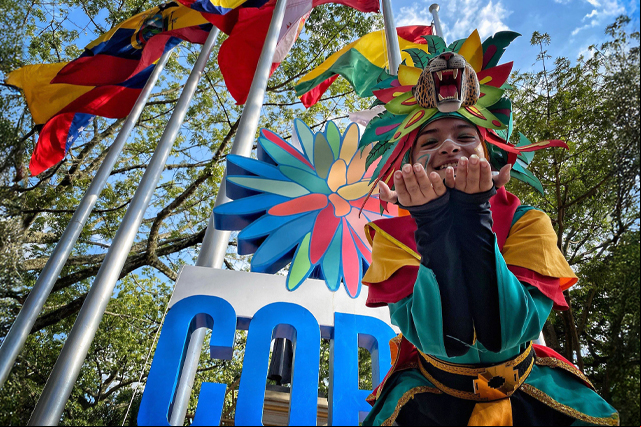
Decisive week for the future of the planet's biodiversity
The official takes stock of the first week of negotiations. She also highlights Cali's positive attitude.
During COP16, Environment Minister Susana Muhamad may attend at least three press conferences a day, attend plenary sessions, talk to negotiators, focus on mining protests, and then head to a summit where she is not only a host government official but also the president of the conference. In the midst of this busy schedule, she took some time to talk to EL TIEMPO and give her assessment of the first week of the meeting.
The head of the environment portfolio highlights the work done by all civil society around the summit and assures that progress has been made on some key issues, although she its that others could be delayed during the two weeks of discussions.
Everything is happening in these negotiations, but I would like to highlight the very positive atmosphere that Cali society, the visitors from Colombia, and the great social mobilization that COP16 has generated in general have created as a political environment for the negotiations. It was a very positive atmosphere; all the international delegates expressed their gratitude for the mobilization and the welcome they received from the Colombian people here in Cali. Second, we started the COP negotiation process at a good pace. We were able to set up the working groups quickly, the negotiations on fundamental issues started practically from the first night, and this is also a good sign that the parties are willing to move forward and that the results will be successful. And third, the political declarations and the number of events and discussions that have taken place both in the Green Zone and here in the Blue Zone on the part of all the actors. I would like to highlight the Declaration of the Parliamentary Forum, with parliamentarians from different parts of the world, the Women's Declaration, the Inírida Declaration, the Indigenous Peoples' Declaration, the Afro-descendant Forum, also to express their position, and I believe that this generates a lot of social appropriation of the COP and the Montreal Framework and citizen participation.
There is progress on the implementation framework, important progress on the workplan article on indigenous peoples and local communities. There is also important progress on the issue of genetic sequences of digital databases. Above all, I would like to emphasize that there is a constructive atmosphere of wanting to move the process forward. Now we have a more polarized and more difficult situation in of resource mobilization and financial issues.
These negotiation processes have several stages, and these stages have to be exhausted. The negotiation can take two whole weeks. But what I want to say is that there is a constructive atmosphere of the parties in the process. There are times when the negotiations are blocked because some parties want to block the negotiations. That has not happened yet, and progress is being made in an important and constructive way. In other words, the parties are putting ideas on the table to resolve the issues that are still under discussion. But we will see how it goes. Everything is moving here.
There are some concerns. We believe that there is still a lack of understanding of the proposal, but this proposal is already in the text and that is already important. It is still in brackets, so it is not a decision, it is not a consensus, it is not a clean text, but it is in the text and that is good news. Colombia and Brazil have managed to produce a text that allows it to be included, and that means that it is already the subject of negotiations, and that is an important step forward.
We cannot create the change that is needed based on what we can do, but the other way around, we have to define what is needed and then go back to how we create the capacity to do it. That is the process, that goal was not set by the Ministry of Environment, but it is a process of consultation and work... If you have 23 million hectares that we should put into restoration in the country and we put 5 million hectares, then you are addressing at least a quarter of the problem. When we see today the emergencies caused by climate change, droughts, emergencies caused by excessive rainfall, that is where we need to do this environmental restoration. And if we as a country do not propose it, what are we saying? That we are destined to have more and more disasters, that the water situation is going to get worse and worse. That is not the response of a government and a society. Here we want to say that what we all have to do is to take this small example of the COP that we did as a miracle: in eight months we organized something of a dimension that nobody had planned, but it was because of the mobilization of everybody that we achieved it, the synergy that produced this result.
To restore biodiversity and make progress on these goals, we need to mobilize all of government and all of society. I am sure that there are capacities here that we do not see today, but that if we come together, they will emerge in a very beautiful way, and I believe it will be very powerful. And I believe, as a minister, that it is a commitment of all of us, of the institutions that you represent, of civil society.
That is why the President has always extended his hand for total peace. The President has initiated a process of dialogue, and I believe that with this COP16 there is a message to the actors who are still in arms: there is a process of social justice, environmental justice, social justice of the most abandoned territories, there is a mobilization of society, they could be a constructive part of it. The truth is that today they are an obstacle in this situation of illegal economies and armed struggles, but this can change.Peace with nature can call us to do this, and it is the call, but it must also be said that it is not only the illegal economies, although they have a devastating impact, it is also our extractivist development model that has generated this process. The greatest loss of biodiversity in this country has occurred in agricultural practices and the concentration of agricultural lands; this is the greatest historical loss of biodiversity in the country. And then the whole process of extractivism. So the logic of the development model has to be questioned in a constructive way in order to develop alternatives that will allow us to be stronger in the face of these environmental crises.
Yes, I think so. It is in the public discussion, it is in the common sense of the people, it is beginning to be a discussion, it is beginning to be something important. The new generations of this country are impressive in their knowledge and their ability to understand the situation. The private sector is also very involved, the banks, the alternative media, the mass media. Really, yes, it was a great mobilization. Our goal was to make the COP the biggest environmental classroom that Colombia has ever had, and I think we are all achieving that.
EDWIN CAICEDO and ERNESTO CORTÉS
Environment Desk
Editor's note: This text is an artificially intelligent English translation of the original Spanish version, which can be found here. Any comment, please write to [email protected]
Swipe left to navigate

Matthias Berninger spoke to EL TIEMPO about the role of the private sector in mitigating the impact on biodiversity.

On Tuesday, at the opening of the final segment of the meeting, six heads of state and the UN Secretary-General called for the urgency of the crisis to be addressed.

Nonhle Mbuthuma, winner of the Goldman Prize, the 'Nobel Prize for environmentalists', says the big environmental problem today is the global economic model.

The Lancet Countdown 2024 reports that the human cost of global warming continues to rise.

More than 50 science faculties in the country pledged to reform their curricula to address the biodiversity crisis.

Initiative to rehabilitate the affected areas. It started in 2018, driven by the National Police, and today it is in the hands of the Water Police, with the United States Government and the University of Cordoba.

At COP16, handed over three pieces of Kogui ritual artefacts that had been in the Ethnological Museum in Berlin for more than a century.

In an interview with EL TIEMPO, the European Union's (EU) Director-General for Environment spoke about the challenge of raising more money for biodiversity.

UN Secretary-General addresses the presence of Venezuelan Foreign Minister Yvan Gil at the Cali Biodiversity Summit.

The UN chief spoke to the media on Wednesday about the biodiversity summit, Venezuela and drug trafficking.

This agreement, within the framework of COP16, is an opportunity to consolidate peace and contribute to the protection of the environment.

A fierce debate is raging in Mexico over the construction of a gas terminal. Organisations such as the Ocean Future Society and of the National Geographic Society have issued warnings.

Banking leaders met during COP16 in Cali. 'We want to increase the portfolio by a factor of six,' they said.

The President's day at COP16 included bilateral meetings, while his absence from an event in Cali raised concerns.

The money will help combat large-scale illegal deforestation and environmental crimes, and strengthen sustainable forest management.

Audiovisual competition to be held in Cali for the first time as part of COP16.

At the summit, the agency unveiled a tool to help countries define their biodiversity conservation goals, taking into sustainable agriculture.

This audio-visual production describes Elvira Alvarado's efforts to preserve and restore the reefs in the north of the country.

In Colombia, the world is looking for mechanisms to mobilise $200 billion a year.

EL TIEMPO spoke to researcher Mathis Wackernagel, who reiterates that it is the opportunity for change to regenerate ecosystems as the capital of sustainable development.

By early 2024, early warnings of deforestation were on a steep upward curve, according to Ideam.

The initiative is being launched today with the aim of recruiting more countries and involving people in the movement to restore and protect biodiversity around the world.

Environmental authorities, the cattle ranching company Empopasto and the European Union's Euroclima have pledged to protect the hydrographic region.

At least five presidents will attend the high-level segment on October 29.

They expect the formulation of policies and the creation of a subsidiary body that recognizes their contributions to the Convention on Biological Diversity.

The official takes stock of the first week of negotiations. She also highlights Cali's positive attitude.

A study by the Royal Botanic Gardens, Kew, in the United Kingdom, has identified 33 places where efforts to learn more about biodiversity should be prioritized.

Inger Andersen gives her assessment of COP16 and what was achieved. She also praised the work of Colombia.

The expansion of a wildlife sanctuary in the Chocó Caribbean has been stopped in 2022. There is a dispute between two entities.

Until now, no organisms were known to survive above the peat bogs. An Ideam study has found that they do exist, but they are endangered.

EL TIEMPO visited the home of Jesús Leonardo Escobar, who had the animal, which was almost three meters long. This is the story.

The cultural agenda continues through October 27 with concerts and artistic performances in various parts of the Green Zone.

Mayors from Bogotá, Medellín, Cali, Florencia and other cities spoke at the Summit on Development and Biodiversity.

The governor of Tolima, Adriana Matiz, referred to the Summit for the Defense of the Andes and expressed her opinion on the debate that defines the budget of the General Royalties System.

The term was defined by the American Psychological Association in 2017. An expert explained its scope to EL TIEMPO.

Así lo indicó el Ministro del Interior durante un evento en la COP16, que se adelanta en Cali.


















These charts are in their original Spanish version.






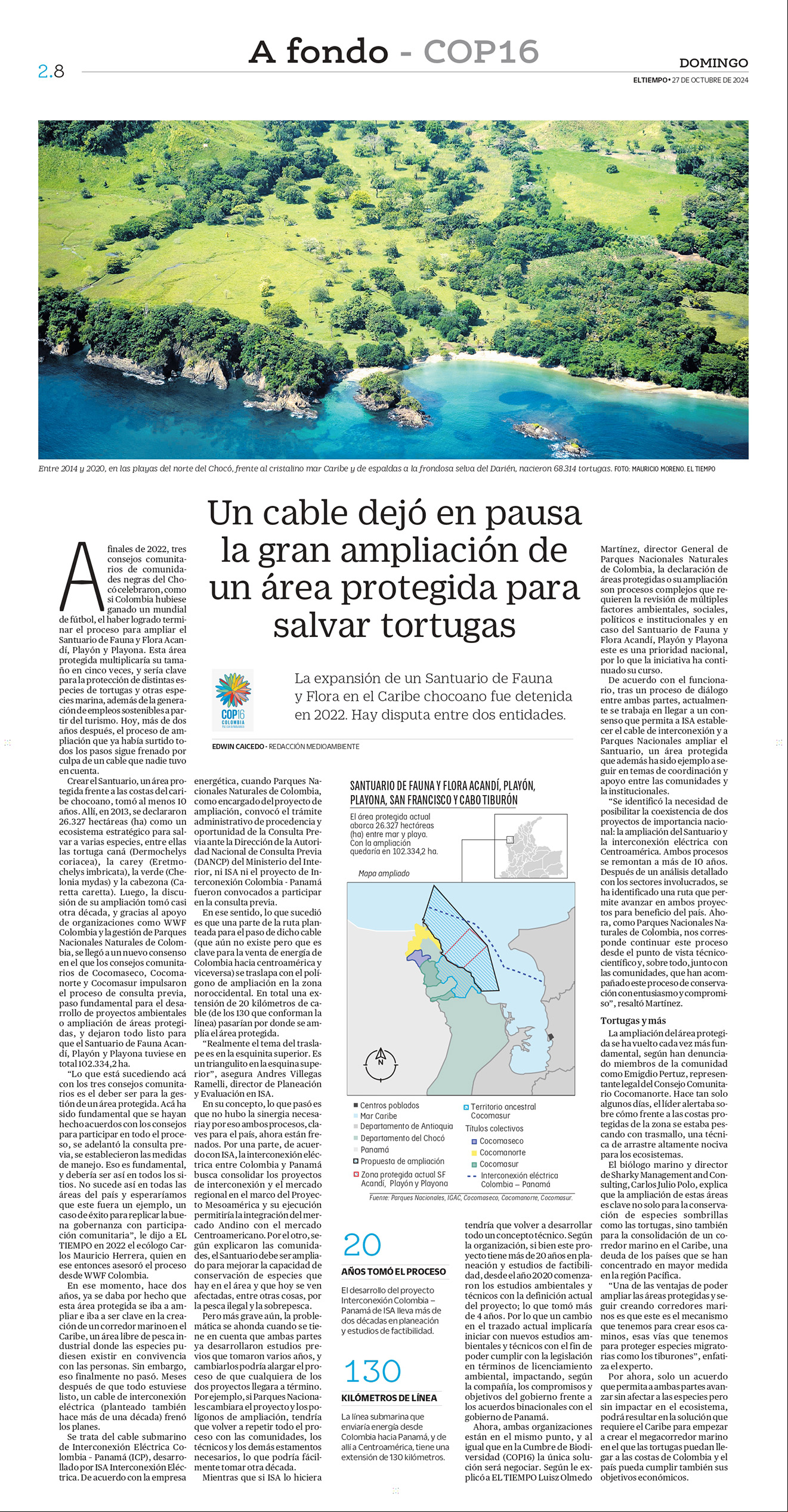

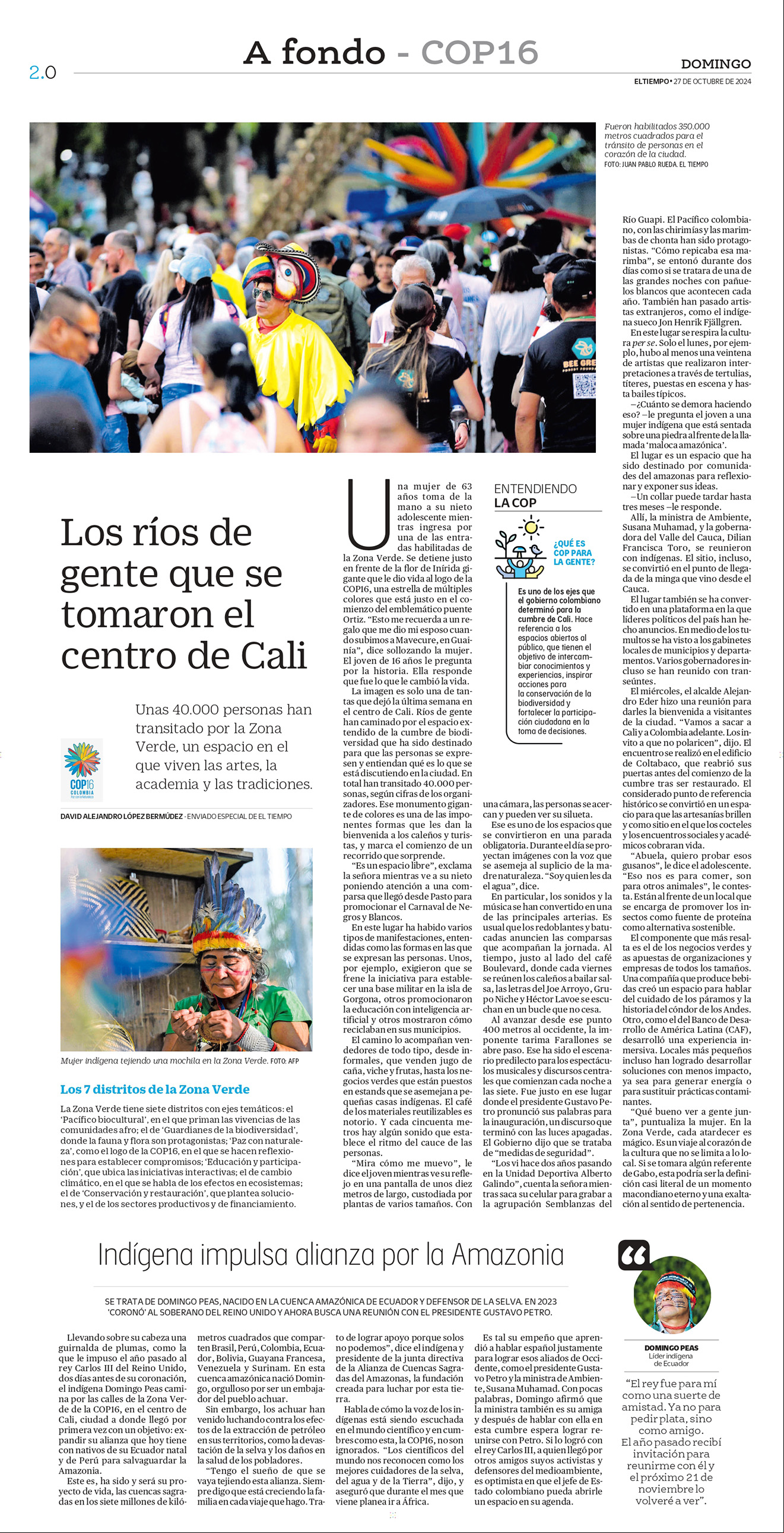
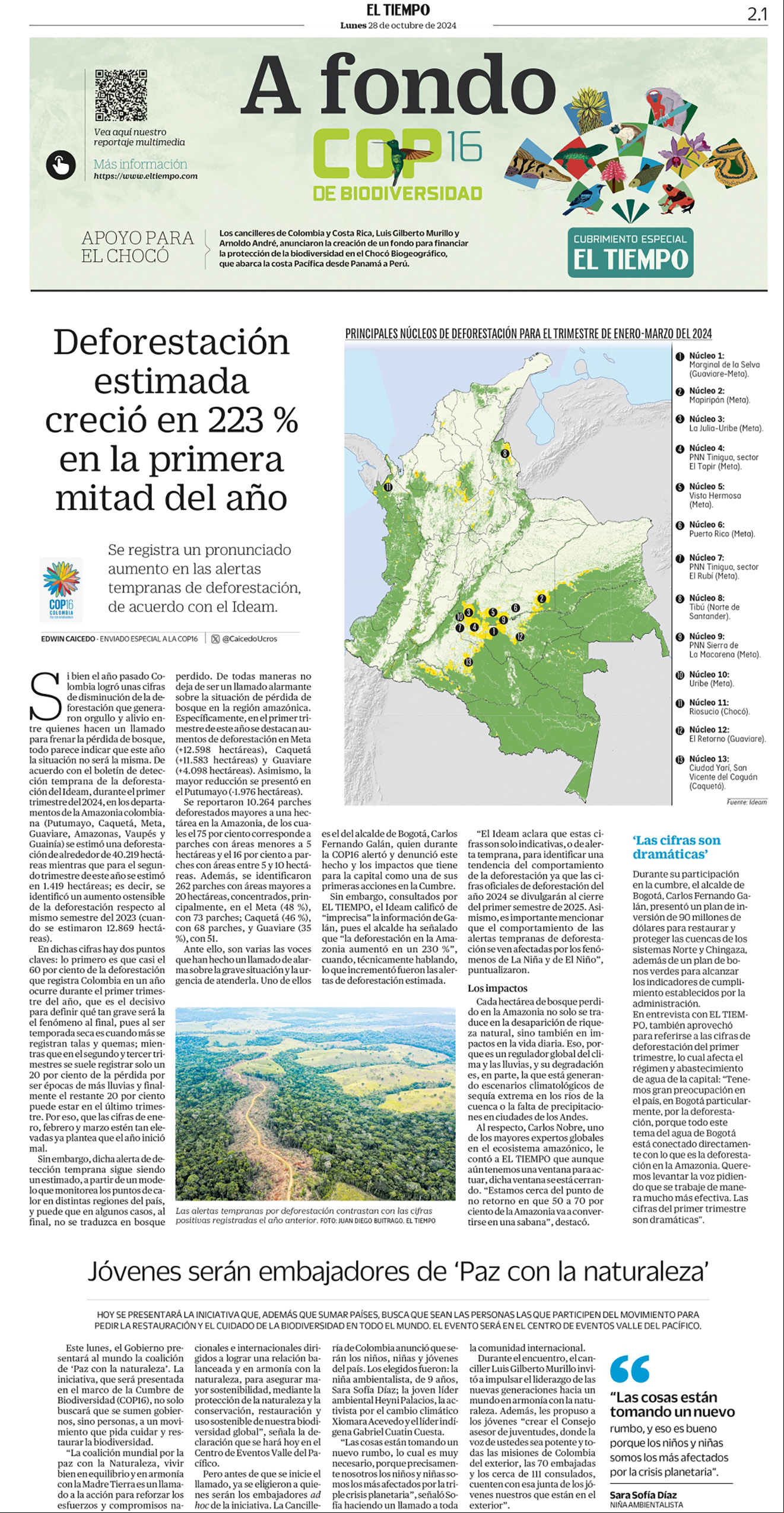














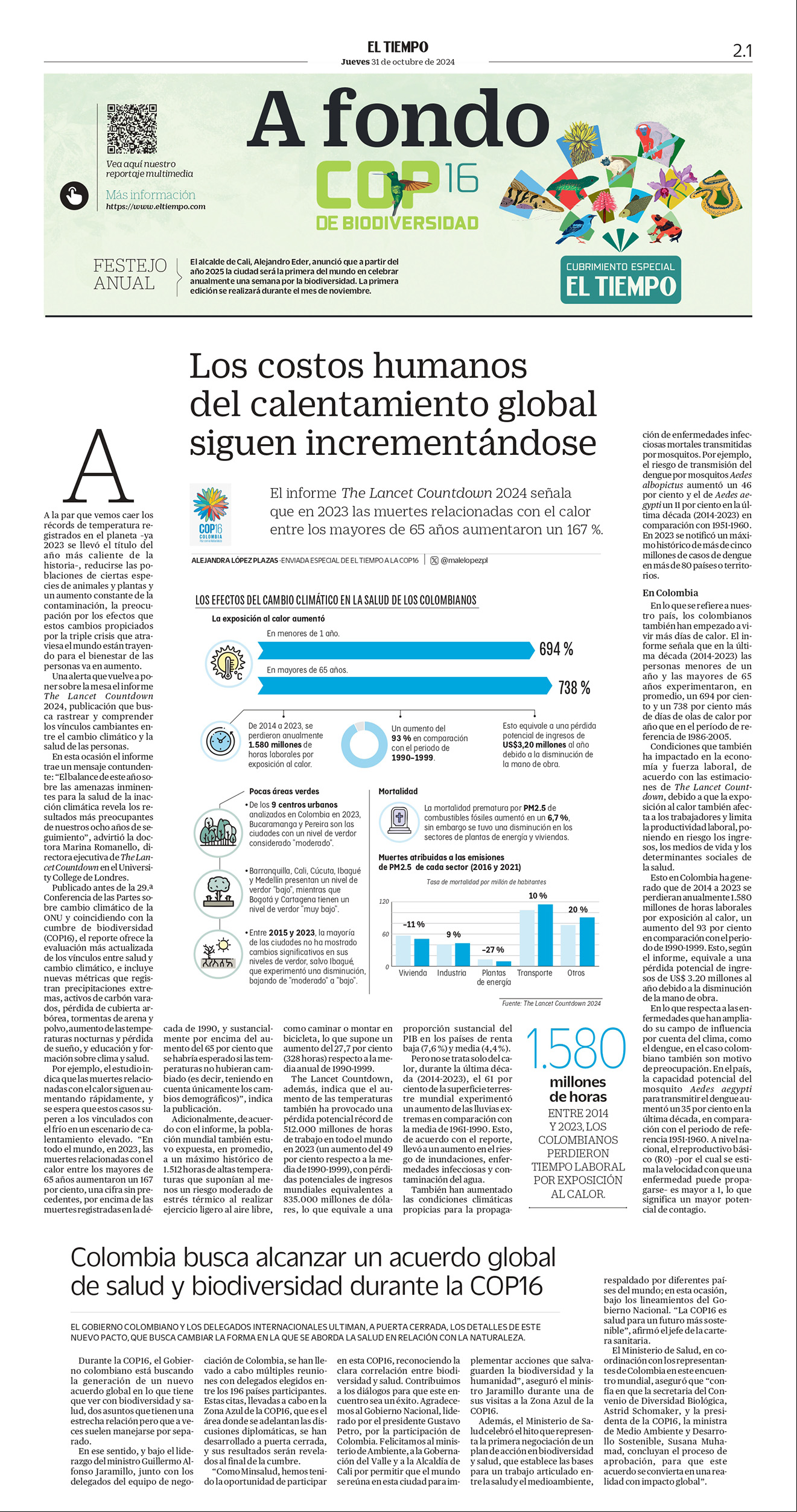

















Conforme a los criterios de
Desde que se confirmó a Cali como sede de la COP16, la Casa Editorial EL TIEMPO ha cubierto toda la preparación y las decisiones para su realización. Y seguirá haciéndolo en las semanas previas al evento, durante su desarrollo y los efectos posteriores de lo que allí se determine.
El cubrimiento multimedia se presentó el lunes 2 de septiembre y será diario por al menos dos meses. En las páginas impresas y las plataformas digitales, las personas podrán encontrar toda la información relacionada sobre esta cumbre, entrevistas exclusivas, análisis e informes especiales. Además, un alto contenido gráfico, con explicaciones, datos y radiografías que dan cuenta de la situación actual de la biodiversidad en Colombia y el planeta, los desafíos por cómo actuar de la humanidad y qué se hace para preservar y conservar la fauna, flora y los ecosistemas.
La información es obtenida de fuentes oficiales involucradas en el desarrollo del evento, como los ministerios de Ambiente, Cultura y Cancillería, la alcaldía de Cali y la gobernación del Valle del Cauca, y el Convenio sobre la Diversidad Biológica (CBD, por sus siglas en inglés).
Desde el 21 de octubre al primero de noviembre, un equipo periodístico multimedia de 15 personas será el encargado de llevar las historias que sucedan durante la cumbre, los diálogos entre jefes de Estado y delegaciones de los países asistentes, y las actividades paralelas que sucedan. Además, habrá un boletín de correo electrónico exclusivo para que los s registrados tengan, de primera mano, la información confirmada y actualizada.
Convenio sobre la Diversidad Biológica https://www.cbd.int/
COP16 Colombia, página oficial https://www.cop16colombia.com/es/
Programa de la ONU para el medio ambiente https://www.unep.org/es
Ministerio de Ambiente y Desarrollo Sostenible de Colombia https://www.minambiente.gov.co/
Ministerio de Cultura de Colombia https://www.mincultura.gov.co/
Cancillería de Colombia https://www.cancilleria.gov.co/
Alcaldía de Cali https://www.cali.gov.co/
Centro para los Objetivos de Desarrollo Sostenible, Universidad de Los Andes https://cods.uniandes.edu.co/
Red nacional de datos abiertos sobre biodiversidad (SiB) https://biodiversidad.co/
Reportes y colecciones sobre biodiversidad, Instituto Humboldt http://reporte.humboldt.org.co/ biodiversidad/
Colecciones e informes de BBC Earth https://www.bbcearth.com/
BirdLife International https://datazone.birdlife.org/ country